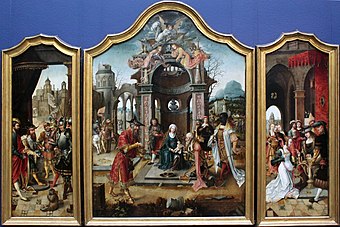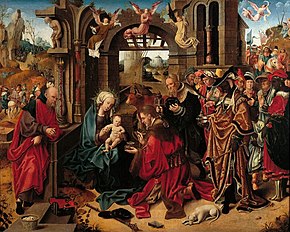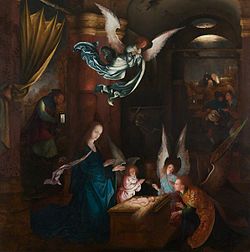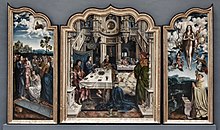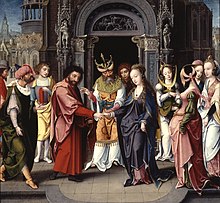Antwerp Mannerism
[3] Joseph Koerner notes "a diffuse sense of outlandishness in Antwerp art, of an exoticism both of subject and means ... evoking a non-localized elsewhere".
[4] The subject of the Adoration of the Magi was a particular favourite, as it allowed the artists to give free rein to their preoccupation with ornament and the simulation and imitation of luxury products.
[5] The Biblical Magi were also regarded as the patron saints of travellers and merchants, which was relevant for the painters' clientele in what had become Europe's main centre for international trade, in a "meteoric rise" after 1501, when the first Asian cargos were landed by Portuguese ships.
[6] The theme of rich commodities arriving from distant and exotic parts of the world had a natural appeal to Antwerp merchant buyers, a large proportion themselves foreign.
Many artists from around the Netherlands and further afield moved to the city to benefit from the boom, which saw large workshops "that grew into assembly lines", and a great increase in the quantity of art produced, but also some fall in quality; this is especially seen among the minor figures grouped under this term.
The Antwerp Pand was a trade fair lasting six weeks, where many painters sold works, and the latest ideas were exchanged and diffused.
[25] The Antwerp Mannerists typically depicted religious subjects, which they interpreted generally in a more superficial manner than the Flemish artists of the previous century in favour of a more fluid form and an abundance of meticulously rendered details.
Their "essentially late Gothic style is characterized by calligraphically complicated compositions peopled with elongated, theatrically-dressed figures animated by improbable poses and repetitive gestures".
The Mannerist painters show very little evidence of having visited Italy (where Jan Gossaert had been in 1508–09), and their idea of alla antica style must be derived from Italian prints, and sometimes drawings.
At this period painters or other artists were the usual designers of buildings, especially their ornament, and until a court case in Utrecht in 1543, master-masons were prohibited from doing so there by guild restrictions.
[32] The fantastic and exotic costumes many characters wear were already a feature of Early Netherlandish painting in the previous century, and the Biblical Magi and their retinues gave one of the most typical settings for this.
The emperor's stylish hat, with a long pointed peak in front, seen on the Medal of John VIII Palaeologus, was especially popular, and versions appear in a good proportion of paintings of the Magi (as in some illustrated here).
[40] Apart from the Adoration of the Magi, many of the panels or triptychs produced by the Antwerp Mannerists depicted the major events in the Life of Christ, including the Nativity, and the Crucifixion.
